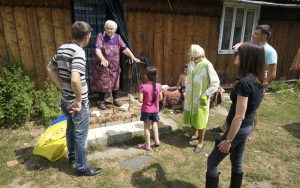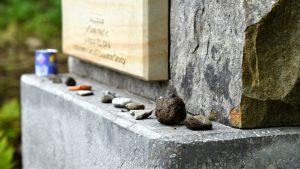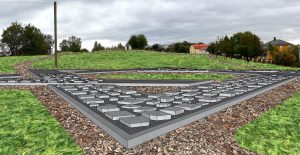
Speaking with village elders about the Jewish cemeteries in Svirzh, roughly 30km north of Rohatyn. Photo © RJH.
The results of my 2019-2020 Fulbright project are now online and available to the public on a new website: “A Guide to Jewish Cemetery Preservation in Western Ukraine”.
![]() Ця стаття також доступна українською.
Ця стаття також доступна українською.

Pebbles placed during the dedication of a memorial monument in Nadvirna, about 90km south of Rohatyn, from one of 16 documented regional project case studies. Photo © NSRG.
Though initially more narrowly defined as a demonstration project for Jewish cemetery preservation in the region using Rohatyn’s “old” Jewish cemetery as example, it became clear once the Fulbright research got underway that there were much larger issues and broader applications that could be useful to others wishing to initiate, manage, and sustain a heritage project. So Jay and I decided to broaden the scope of the Fulbright project to include references and resources, tables listing all of the documented Jewish burial sites (cemeteries and wartime mass graves) in the three historic eastern Galician regions of western Ukraine (Lviv, Ternopil, and Ivano-Frankivsk oblasts), and 16 in-depth case studies of actual on-the-ground projects (past, ongoing, planned, or waiting) which present, among other things, project costs, issues of fundraising and maintenance, methods for developing local partners, and challenges of sustainability.

A simulated view of the new memorial design for the Rohatyn old Jewish cemetery, from the perspective of a visitor. Image © RJH.
Still included in the results is the original Fulbright project proposal of presenting best practices for cemetery care and management and a detailed plan to rehabilitate Rohatyn’s old cemetery. The cemetery project plan proposes transforming the historic site from a space of destruction and desecration into a space of remembrance incorporating the hundreds of headstone fragments Rohatyn Jewish Heritage has recovered over the last 9 years from roads, walkways, private gardens, and building foundations in town. Portions of the plan can next be sent out for final design and construction bids, after which they can be considered by Rohatyn descendants and supporters for fundraising, aiming for realization in 2021.

Setting up a survey grid with tape measures in Rohatyn’s old
Jewish cemetery. Photos © RJH.
With regard to the three tables (by oblast) of Jewish burial sites in eastern Galicia, Jay and I managed before and during the course of the 10-month Fulbright project to visit slightly over half of the more than 500 sites. Doing so not only gave us firsthand knowledge of the current condition of the sites (especially useful for sites which are featured case studies), but also permitted us to gather or correct GPS coordinates so others can find the sites as well. Our hope is that armed with this information, and combined with the data, resources, and information on the new website, Jewish descendants abroad as well as local activists will partner to initiate new heritage projects, whether fencing, signage, or installation of a memorial monument.

A proposed identification sign for the old cemetery in Rohatyn. Image © RJH.
Jay and I would like to thank all of the institutions and individuals who contributed to my Fulbright research with data, references, and advice, and who encouraged us in this project from before I made the application and all through the months which followed.

With a few of the colleagues and knowledgeable local people who have helped us. Photos © RJH.
Although there are some pages remaining to be assembled on the new website, which we aim to finish by the end of 2020, most of the pages are already complete and ready for use at this link – enjoy exploring:
https://jewishheritageguide.net/en
